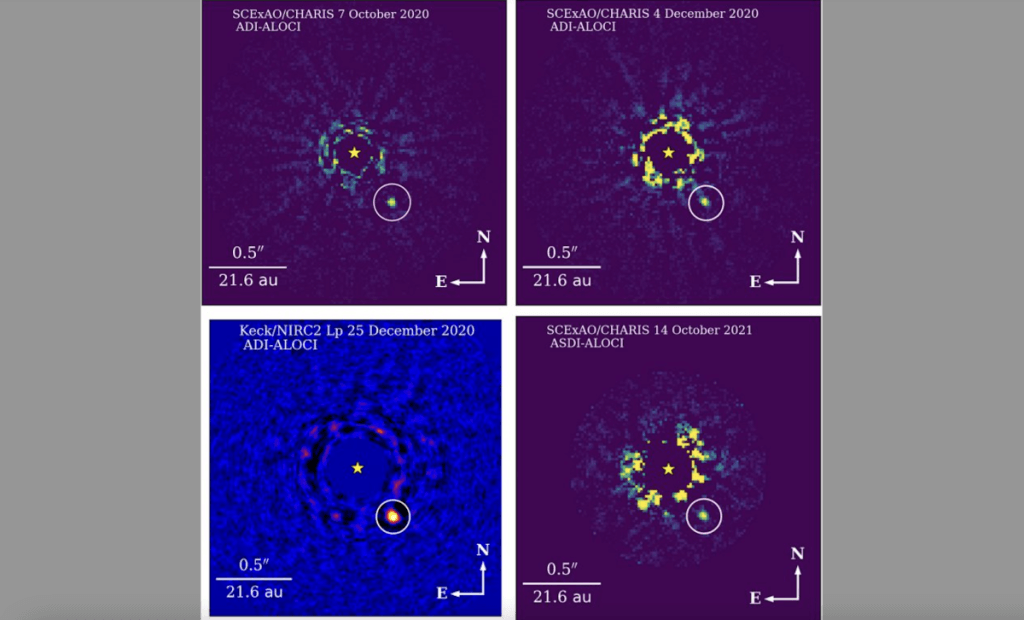
‘Failed star’ brown dwarf imaged in nearby star cluster (photos) (Image Credit: Space.com)
Astronomers have captured a direct image of a nearby brown dwarf, an astronomical body larger than a planet but not big enough to initiate the internal nuclear fusion that powers a star.
For this reason, brown dwarfs are often referred to as “failed stars,” but the dividing line between planets and stars is still poorly understood.
The newly imaged brown dwarf, designated HIP 21152 B, has a mass between 22 and 36 times that of Jupiter, our solar system’s largest planet. The research team also found that the atmosphere of HIP 21152 B has a temperature between 1700 and 1880 degrees Fahrenheit (around 927 to 1027 degrees Celsius) and is currently cooling.
“This result can provide an important clue to understand the atmospheres of giant planets and brown dwarfs based on how and when they show atmospheric characteristics similar to those seen in the planets of the HR 8799 system and HIP 21152 B,” research leader Masayuki Kuzuhara, an assistant professor at the Astrobiology Center, part of the National Institutes of Natural Sciences in Tokyo, said in a statement (opens in new tab) last month.
Related: Brown dwarfs: Strange failed stars of the universe explained (infographic)
The team used the W. M. Keck Observatory and Subaru Telescope on Maunakea in Hawai’i to photograph the brown dwarf, which orbits a young sunlike star located in the Hyades Cluster.
At around 150 light-years from Earth, the Hyades is the closest star cluster to us. Its unique V-shaped structure is visible to the naked eye in the constellation of Taurus, The Bull.
Astronomers are keen to investigate the Hyades because it consists of young stars that were born at almost the same time, meaning it can assist in the investigation of the evolution of stars and their planets.

Why does a star fail?
According to NASA (opens in new tab), the key to understanding a brown dwarf like HIP 21152 B lies in knowing the difference between a star and a planet. A star forms from a dense cloud of gas, which collapses due to its own gravitational pull. As this collapse proceeds, pressures and temperatures at the protostar’s core eventually become so great that they trigger the nuclear fusion of hydrogen into helium.
This stage of a star’s life is described as the “main sequence,” and the nuclear fusion process acts as the chief source of the star’s energy output (and light emission).
Planets form from the leftover gas and dust that don’t get incorporated into the nascent star. These particles clump together, but they don’t reach masses great enough to create the pressure and temperature needed to initiate fusion.
Brown dwarfs are considered to be objects with between 15 to 75 times the mass of Jupiter, which is also insufficient to sustain the fusion of hydrogen. Because they share some characteristics with gas giants, brown dwarfs are useful for studying the evolution and atmospheres of huge planets.
Astronomers confirmed that brown dwarfs exist in 1995 and have since discovered thousands of these objects, but the frequency of companion-type brown dwarfs has remained low, just a few per 100 or so stars. This has led to astronomers searching for an effective way to discover these substellar bodies in binary systems.
Until recently, astronomers have detected brown dwarfs chiefly by measuring the influence they have on their binary partner stars — namely, the “wobble” their gravitational pull induces in the motion of the companion star.
The brown dwarf HIP 21152 B represents the first substellar companion of a main sequence star in the Hyades cluster to be discovered using direct imaging, the research team said. Direct imaging of brown dwarfs is significant because these dim, difficult-to-observe objects don’t give off significant light of their own and could therefore account for some portion of the universe’s “missing mass.”
“It is expected that HIP 21152 B will play an important role as a benchmark for future progress in astronomy and planetary science,” Kuzuhara said.
The team’s research was published last July in The Astrophysical Journal Letters (opens in new tab).
Follow us on Twitter @Spacedotcom (opens in new tab) and on Facebook (opens in new tab).





